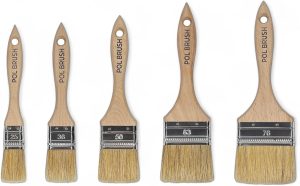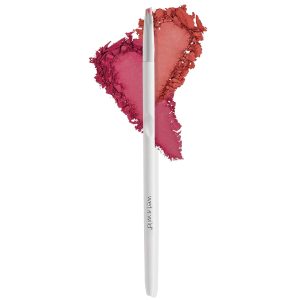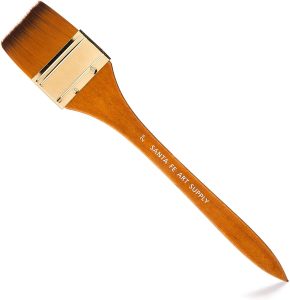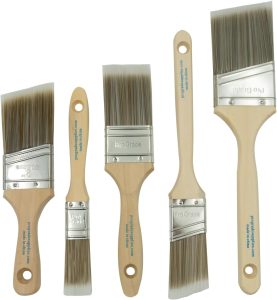Painting metal surfaces can be challenging due to their smooth, often non-porous finish, but with the right brush and technique, you can achieve a flawless, long-lasting result. Whether you’re working on a metal sculpture, furniture, hardware, or any other metal object, selecting the right brush is crucial for getting smooth, even coverage without leaving brush marks or ruining the finish.
We will explore the best types of brushes for painting metal, along with some tips for achieving the best results. We’ll also answer frequently asked questions to ensure you’re equipped with everything you need to paint metal like a pro.
Types of Brushes for Painting Metal
When selecting a brush for painting metal, it’s essential to consider the specific properties of both the metal and the paint you’re using. There are different types of brushes designed to handle various tasks, including smooth application, intricate detailing, and durability.
Let’s dive into the best brush types for painting metal.
1. Synthetic Bristle Brushes

Synthetic brushes are made from man-made fibers such as nylon or polyester. They are a popular choice for painting metal because they are versatile, durable, and maintain their shape over time.
- Pros:
- Perfect for water-based and oil-based paints.
- Hold paint well and provide even coverage.
- Easier to clean than natural bristle brushes.
- Do not shed fibers easily.
- Best For: Synthetic brushes are excellent for general metal painting tasks, such as coating larger surfaces or intricate work on metal furniture, gates, and outdoor metal objects.
2. Natural Bristle Brushes

Natural bristle brushes are made from animal hair, usually hog or sable. They are favored for oil-based paints, which tend to have a thicker consistency. Natural bristles offer a smooth finish and are perfect for detailed, fine work.
- Pros:
- Ideal for oil-based paints and varnishes.
- Provide a smooth, fine finish without brush strokes.
- Hold more paint, reducing the number of dips needed.
- Best For: Natural bristle brushes are best used for oil-based paints and varnishes on metal objects like metal sculptures, gates, or furniture where a smooth finish is essential.
3. Flat Brushes

Flat brushes have wide, square-shaped bristles that allow for quick coverage of larger metal surfaces. They are available in both synthetic and natural bristles, and they can help you apply paint evenly with minimal brush strokes.
- Pros:
- Great for large metal surfaces such as metal doors, fences, and appliances.
- Offer more control for a smoother, even coat.
- Ideal for both oil-based and water-based paints.
- Best For: Use a flat brush to paint large, flat metal surfaces such as doors, window frames, and walls.
4. Angled Brushes

Angled brushes have bristles that are cut at a slant, making them perfect for getting into corners and edges. They allow for precise application and are often used for more detailed painting tasks.
- Pros:
- Perfect for trimming around edges and corners.
- Provide a clean line for fine detail work.
- Ideal for controlled, precise application.
- Best For: Angled brushes are ideal for getting into the edges of metal objects, such as the corners of a metal gate or the edges of metal furniture. They are also great for painting intricate patterns and designs.
5. Round Brushes

Round brushes have a point at the tip, which makes them great for precise detailing and painting small areas on metal surfaces. They are generally used for touch-ups and painting fine details.
- Pros:
- Excellent for detailing and small projects.
- Provide a sharp point for intricate designs and fine lines.
- Available in a variety of sizes, so you can choose one that fits your project.
- Best For: Round brushes are excellent for adding details like designs, highlights, and trim work on metal objects. They are also ideal for painting smaller areas or applying touch-ups to areas that larger brushes can’t reach.
Best Brushes for Painting Metal
Here are some of the best brushes on the market that are perfect for painting metal:
1. Purdy 144080320 ClearCut Angular Sash Brush

- Type: Angled Synthetic Brush
- Best For: Fine detailing, edges, and corners.
- Why It’s Great: Purdy’s ClearCut Angular Sash Brush is a high-quality, synthetic brush designed for precision. It’s perfect for painting metal surfaces in tight spaces, and it holds its shape well, providing smooth application and reduced brush marks.
2. Wooster 2-1/2″ Silver Tip Angle Sash Brush

- Type: Angled Synthetic Brush
- Best For: Detailed, sharp lines and precise painting.
- Why It’s Great: Wooster’s Silver Tip is designed for use with both oil-based and water-based paints, making it versatile for a variety of metal projects. Its angled shape allows for precision when painting metal objects with intricate edges.
3. Behr Premium 2-Inch Flat Brush

- Type: Flat Synthetic Brush
- Best For: Smooth coverage on large, flat metal surfaces.
- Why It’s Great: Behr’s premium flat brush provides excellent coverage with minimal brush marks, making it perfect for painting large metal surfaces such as doors, window frames, or metal furniture.
4. Zibra Paint 2-Inch Grip & Glides Brush

- Type: Synthetic Flat Brush
- Best For: Large surfaces and even coating.
- Why It’s Great: The Zibra Grip & Glides brush offers a smooth application and is known for its high durability. It’s particularly useful for covering large metal surfaces with minimal effort, making it a solid choice for projects like metal railings or gates.
5. Benjamin Moore 2.5-Inch Regal Gold Sash Brush

- Type: Synthetic Sash Brush
- Best For: Precision and fine detailing on metal.
- Why It’s Great: This high-quality synthetic brush is specifically designed for a smooth finish on metal surfaces. It’s great for projects that require detail work and sharp lines.
6. Pro Grade Paint Brushes – 5-Piece Set

- Type: Flat and Angled Synthetic Brushes
- Best For: Versatility and all-around performance.
- Why It’s Great: This affordable set includes a variety of brush sizes and shapes, allowing you to tackle everything from large metal surfaces to detailed work. The synthetic bristles make it a great option for both oil and water-based paints, giving you flexibility for different projects.
Tips for Painting Metal with Brushes
Achieving a smooth, durable finish on metal can be tricky, but with the right brush and proper technique, you can create a professional-looking result. Here are some helpful tips for painting metal surfaces:
1. Prepare the Surface
Before applying paint to metal, ensure that the surface is clean, dry, and free from rust, dirt, grease, or old paint. Sanding or using a metal primer can help the paint adhere better to the metal.
2. Choose the Right Paint
Select a paint that’s designed for metal surfaces. Oil-based paints, enamel paints, or spray paints are often ideal for metal, but there are also specialized paints for metal that can offer extra durability and protection.
3. Use Thin Coats
For a smooth finish, apply thin layers of paint rather than a thick coat. Thin coats dry faster, reduce brush strokes, and prevent paint from dripping or pooling on the metal.
4. Use Proper Brush Technique
Always apply paint in the same direction as the metal’s grain or texture. Avoid pressing too hard on the brush, as this can cause bristle marks. Instead, use long, smooth strokes to get even coverage.
5. Clean Brushes After Use
To prolong the life of your brush, clean it thoroughly after each use. Use a paint thinner or solvent that is compatible with the type of paint you’ve used (for example, mineral spirits for oil-based paints). Rinse the brush under warm water if you used water-based paints.
Conclusion
Choosing the right brush for painting metal surfaces is essential for achieving a smooth, professional-looking finish. Whether you’re working with large metal surfaces, intricate designs, or small touch-ups, there’s a brush out there to suit your needs. Synthetic brushes are versatile and work well with both oil-based and water-based paints, while natural bristle brushes provide a smooth finish for oil-based paints.
Flat, angled, and round brushes each offer their own advantages depending on the type of project you’re working on. Invest in a high-quality brush and apply proper techniques, and you’ll be able to achieve an exceptional finish on your metal projects. Happy painting!


Leave a Reply